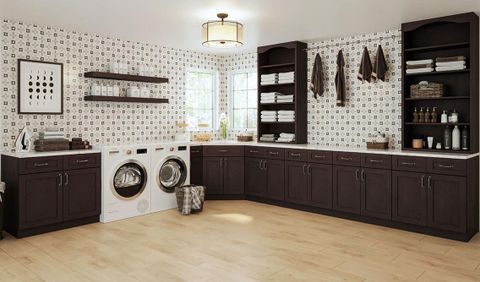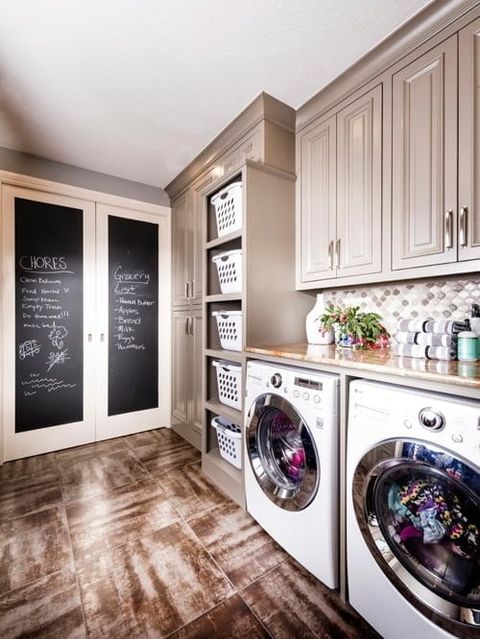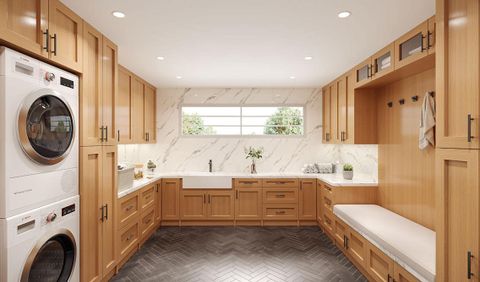In a world where our homes are increasingly cluttered with gadgets, appliances, and storage solutions, one space is experiencing a quiet revolution. The laundry room, once seen as just a utilitarian necessity, is being reimagined as a sanctuary of simplicity and function. Homeowners across the country are discovering that less truly can be more when it comes to their washing and drying areas.
Picture this: a clean, uncluttered space with just enough room to move around comfortably. No overwhelming cabinets, no confusing array of gadgets, just the essentials working together seamlessly. This isn’t some dreamy fantasy – it’s becoming a reality for many homeowners who are embracing minimalist laundry rooms. These spaces are proving that functionality and aesthetics don’t have to be mutually exclusive. In fact, they can work hand-in-hand to create something truly special. The appeal isn’t just about looking good – it’s about creating a space that actually works better for daily life.
What Makes a Laundry Room Minimalist?
A minimalist laundry room isn’t about deprivation or sacrificing comfort. Instead, it’s about intentional design that focuses on purposeful elements. The core idea centers around eliminating anything that doesn’t serve a clear function. Think of it like decluttering your life – you keep only what adds genuine value.
Key characteristics include:
• Single, well-chosen appliance rather than multiple machines
• Streamlined cabinetry with limited storage options
• Neutral color palettes that create visual calm
• Clean lines and simple architectural elements
• Thoughtful placement of items for easy access
The beauty lies in the balance between simplicity and practicality. A minimalist approach means choosing quality over quantity, focusing on what matters most. When you strip away the unnecessary, what remains becomes more meaningful.
The Psychology Behind the Appeal
There’s something deeply satisfying about a well-designed, uncluttered space. Psychology research supports this feeling. When we’re surrounded by too many choices or visual distractions, our brains get overloaded. A minimalist laundry room creates mental clarity.
Consider the daily experience:
• No more searching through endless shelves for the right detergent
• Clear sightlines mean you know exactly where everything belongs
• Simpler layouts reduce the time spent organizing
• Less visual noise means less stress during busy mornings
This psychological benefit extends beyond just the immediate experience. People often report feeling more relaxed and efficient in their minimalist spaces. It’s like having a calm center in the midst of daily chaos. The reduction of decision fatigue is real – when you don’t have to choose between dozens of similar items, you save mental energy for more important things.
Practical Benefits for Daily Life
The advantages of minimalist laundry rooms go far beyond aesthetics. They’re designed to improve real-world functionality.
Time-saving benefits:
• Quick access to frequently used items
• Simplified routines that take less mental effort
• Reduced time spent sorting and organizing
• Easier maintenance and cleaning
Space efficiency is another major perk. Smaller laundry rooms don’t necessarily mean less capability. With smart planning, even compact spaces can accommodate all necessary functions. The key is strategic thinking about how each element serves its purpose.
Many homeowners find that they actually do more laundry because the process feels less daunting. When the space isn’t intimidating or overwhelming, people are more likely to tackle their loads regularly. It’s a small change that can make a big difference in household management.
Design Elements That Work
Creating a successful minimalist laundry room requires understanding which design elements support the philosophy rather than detract from it.
Color choices play a significant role:
• Light, neutral tones like whites, grays, and beiges create a sense of openness
• Subtle accents can add personality without overwhelming the space
• Consistent color schemes help maintain visual harmony
Storage solutions deserve special attention:
• Pull-out drawers instead of traditional cabinet doors
• Hidden storage for items you don’t want to see
• Multi-functional furniture that serves more than one purpose
• Built-in shelving that maximizes vertical space
Lighting matters too. Natural light is ideal when possible, but good artificial lighting ensures the space feels welcoming and functional. Dimmer switches allow for different moods and times of day. The overall effect should feel bright, clean, and spacious.
Common Mistakes to Avoid
Even well-intentioned homeowners sometimes fall into traps that defeat the minimalist purpose. One common error is trying to do everything at once. The temptation to overhaul the entire space can lead to rushed decisions that don’t hold up.
Other pitfalls include:
• Overthinking the design and losing sight of actual needs
• Choosing expensive items just because they look good
• Forgetting about practical considerations like accessibility
• Not considering how the space will age and change over time
Remember that minimalism isn’t about perfection – it’s about intentionality. If you’re unsure about a particular element, ask yourself if it truly serves a purpose. Sometimes the best minimalist choices are the simplest ones. The goal isn’t to create something that looks like it came from a magazine – it’s to create something that works for your life.
Making It Work for Your Home
Every home is different, which means every minimalist laundry room should reflect those unique circumstances. Start by assessing your current space and identifying what’s working versus what’s problematic.
Questions to consider:
• How much space do you actually need?
• What are your typical laundry habits?
• Do you have specific storage needs?
• What’s your budget range?
The process begins with observation rather than immediate action. Take note of:
• How you currently use the space
• What causes friction in your routine
• Which items you reach for most often
• Where you feel most frustrated or stressed
Once you understand your patterns, you can make targeted improvements. This might mean rearranging existing furniture, adding a few key pieces, or even redesigning the layout entirely. The most successful transformations happen when they’re tailored to fit your lifestyle rather than following generic trends.
The minimalist laundry room movement represents more than just a design fad – it’s a practical response to modern living challenges. As homes become more complex and our lives more demanding, finding spaces that simplify rather than complicate makes perfect sense. These rooms offer a rare opportunity to create a place where functionality and peace of mind work together.
Whether you’re starting fresh or looking to refresh an existing space, the principles of minimalism provide a solid foundation. The key is remembering that this isn’t about deprivation – it’s about focus. When you concentrate on what truly matters, everything else becomes clearer. The result is a laundry room that doesn’t just clean clothes, but also cleanses the mind. After all, if your daily tasks feel effortless and pleasant, you’ve created something worth celebrating.














